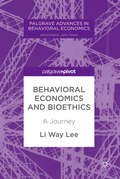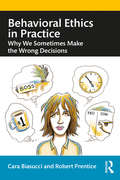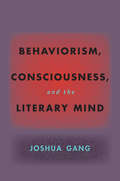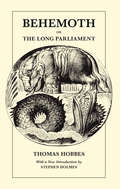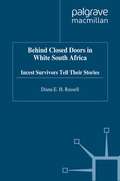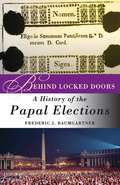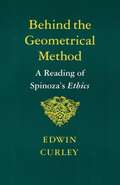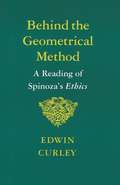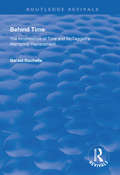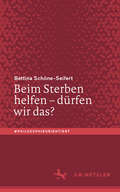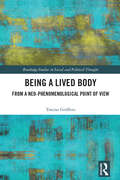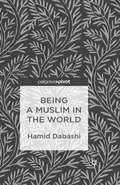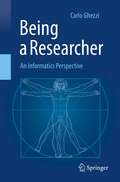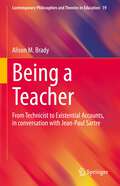- Table View
- List View
Behavioral Economics and Bioethics: A Journey (Palgrave Advances in Behavioral Economics)
by Li Way LeeThis book takes readers on a journey through the wide universe of bioethics, raising the following question: what is the proper attitude towards health, life, and death from the perspective of contemporary behavioral economics? Drawing on fields as diverse as economics, ethics, ecology, biology, and philosophy, this book seeks to uncover the bioethics we accomplish, not the moral principles that we advocate. This book covers life-and-death issues arranged around five themes: selves, persons, populations, species, and “Future Earth”. Ultimately, the author illustrates two kinds of justice: static and dynamic. Static justice prevails whenever parties are free to bargain with each other, while dynamic justice follows from parties' interactions over time. An examination into these types of justice reveals one particularly striking phenomenon: attempts by others to tip the balance of justice have a tendency to backfire. Of primary interest to behavioral economists, this book will also appeal to scholars studying bioethics, ecology, medicine, and philosophy, as well as all people dealing with issues of health, dying, and death.
Behavioral Ethics in Practice: Why We Sometimes Make the Wrong Decisions
by Cara Biasucci Robert PrenticeThis book is an accessible, research-based introduction to behavioral ethics. Often ethics education is incomplete because it ignores how and why people make moral decisions. But using exciting new research from fields such as behavioural psychology, cognitive science, and evolutionary biology, the study of behavioural ethics uncovers the common reasons why good people often screw up. Scientists have long studied the ways human beings make decisions, but only recently have researchers begun to focus specifically on ethical decision making. Unlike philosophy and religion, which aim to tell people how to think and act about various moral issues, behavioral ethics research reveals the factors that influence how people really make moral decisions. Most people get into ethical trouble for doing obviously wrong things. Aristotle cannot help, but learning about behavioral ethics can. By supplementing traditional approaches to teaching ethics with a clear, detailed, research-based introduction to behavioral ethics, beginners can quickly become familiar with the important elements of this new field. This book includes the bonus of being coordinated with Ethics Unwrapped – a free, online, educational resource featuring award-winning videos and teaching materials on a variety of behavioral ethics (and general ethics) topics. This book is a useful supplement for virtually every ethics course, and important in any course where incorporating practical ethics in an engaging manner is paramount. The content applies to every discipline –business ethics, journalism, medicine, legal ethics, and others – because its chief subject is the nature of moral decision making. The book is also highly relevant to practitioners across all sectors.
Behavioral Ethics in Practice: Why We Sometimes Make the Wrong Decisions
by Cara Biasucci Robert PrenticeThis book is an accessible, research-based introduction to behavioral ethics. Often ethics education is incomplete because it ignores how and why people make moral decisions. But using exciting new research from fields such as behavioural psychology, cognitive science, and evolutionary biology, the study of behavioural ethics uncovers the common reasons why good people often screw up. Scientists have long studied the ways human beings make decisions, but only recently have researchers begun to focus specifically on ethical decision making. Unlike philosophy and religion, which aim to tell people how to think and act about various moral issues, behavioral ethics research reveals the factors that influence how people really make moral decisions. Most people get into ethical trouble for doing obviously wrong things. Aristotle cannot help, but learning about behavioral ethics can. By supplementing traditional approaches to teaching ethics with a clear, detailed, research-based introduction to behavioral ethics, beginners can quickly become familiar with the important elements of this new field. This book includes the bonus of being coordinated with Ethics Unwrapped – a free, online, educational resource featuring award-winning videos and teaching materials on a variety of behavioral ethics (and general ethics) topics. This book is a useful supplement for virtually every ethics course, and important in any course where incorporating practical ethics in an engaging manner is paramount. The content applies to every discipline –business ethics, journalism, medicine, legal ethics, and others – because its chief subject is the nature of moral decision making. The book is also highly relevant to practitioners across all sectors.
Behaviorism, Consciousness, and the Literary Mind (Hopkins Studies in Modernism)
by Joshua GangWhat might behaviorism, that debunked school of psychology, tell us about literature?If inanimate objects such as novels or poems have no mental properties of their own, then why do we talk about them as if they do? Why do we perceive the minds of characters, narrators, and speakers as if they were comparable to our own? In Behaviorism, Consciousness, and the Literary Mind, Joshua Gang offers a radical new approach to these questions, which are among the most challenging philosophical problems faced by literary study today.Recent cognitive criticism has tried to answer these questions by looking for similarities and analogies between literary form and the processes of the brain. In contrast, Gang turns to one of the twentieth century's most infamous psychological doctrines: behaviorism. Beginning in 1913, a range of psychologists and philosophers—including John B. Watson, B. F. Skinner, and Gilbert Ryle—argued that many of the things we talk about as mental phenomena aren't at all interior but rather misunderstood behaviors and physiological processes. Today, behaviorism has relatively little scientific value, but Gang argues for its enormous critical value for thinking about why language is so good at creating illusions of mental life.Turning to behaviorism's own literary history, Gang offers the first sustained examination of the outmoded science's place in twentieth-century literature and criticism. Through innovative readings of figures such as I. A. Richards, the American New Critics, Samuel Beckett, Harold Pinter, and J. M. Coetzee, Behaviorism, Consciousness, and the Literary Mind reveals important convergences between modernist writers, experimental psychology, and analytic philosophy of mind—while also giving readers a new framework for thinking about some of literature's most fundamental and exciting questions.
Behaviorism, Consciousness, and the Literary Mind (Hopkins Studies in Modernism)
by Joshua GangWhat might behaviorism, that debunked school of psychology, tell us about literature?If inanimate objects such as novels or poems have no mental properties of their own, then why do we talk about them as if they do? Why do we perceive the minds of characters, narrators, and speakers as if they were comparable to our own? In Behaviorism, Consciousness, and the Literary Mind, Joshua Gang offers a radical new approach to these questions, which are among the most challenging philosophical problems faced by literary study today.Recent cognitive criticism has tried to answer these questions by looking for similarities and analogies between literary form and the processes of the brain. In contrast, Gang turns to one of the twentieth century's most infamous psychological doctrines: behaviorism. Beginning in 1913, a range of psychologists and philosophers—including John B. Watson, B. F. Skinner, and Gilbert Ryle—argued that many of the things we talk about as mental phenomena aren't at all interior but rather misunderstood behaviors and physiological processes. Today, behaviorism has relatively little scientific value, but Gang argues for its enormous critical value for thinking about why language is so good at creating illusions of mental life.Turning to behaviorism's own literary history, Gang offers the first sustained examination of the outmoded science's place in twentieth-century literature and criticism. Through innovative readings of figures such as I. A. Richards, the American New Critics, Samuel Beckett, Harold Pinter, and J. M. Coetzee, Behaviorism, Consciousness, and the Literary Mind reveals important convergences between modernist writers, experimental psychology, and analytic philosophy of mind—while also giving readers a new framework for thinking about some of literature's most fundamental and exciting questions.
Behemoth or The Long Parliament
by Thomas HobbesBehemoth, or The Long Parliament is essential to any reader interested in the historical context of the thought of Thomas Hobbes (1588-1679). In De Cive (1642) and Leviathan (1651), the great political philosopher had developed an analytical framework for discussing sedition, rebellion, and the breakdown of authority. Behemoth, completed around 1668 and not published until after Hobbe's death, represents the systematic application of this framework to the English Civil War. In his insightful and substantial Introduction, Stephen Holmes examines the major themes and implications of Behemoth in Hobbes's system of thought. Holmes notes that a fresh consideration of Behemoth dispels persistent misreadings of Hobbes, including the idea that man is motivated solely by a desire for self-preservation. Behemoth, which is cast as a series of dialogues between a teacher and his pupil, locates the principal cause of the Civil War less in economic interests than in the stubborn irrationality of key actors. It also shows more vividly than any of Hobbe's other works the importance of religion in his theories of human nature and behavior.
Behemoth or The Long Parliament
by Thomas HobbesBehemoth, or The Long Parliament is essential to any reader interested in the historical context of the thought of Thomas Hobbes (1588-1679). In De Cive (1642) and Leviathan (1651), the great political philosopher had developed an analytical framework for discussing sedition, rebellion, and the breakdown of authority. Behemoth, completed around 1668 and not published until after Hobbe's death, represents the systematic application of this framework to the English Civil War. In his insightful and substantial Introduction, Stephen Holmes examines the major themes and implications of Behemoth in Hobbes's system of thought. Holmes notes that a fresh consideration of Behemoth dispels persistent misreadings of Hobbes, including the idea that man is motivated solely by a desire for self-preservation. Behemoth, which is cast as a series of dialogues between a teacher and his pupil, locates the principal cause of the Civil War less in economic interests than in the stubborn irrationality of key actors. It also shows more vividly than any of Hobbe's other works the importance of religion in his theories of human nature and behavior.
Behemoth or The Long Parliament
by Thomas HobbesBehemoth, or The Long Parliament is essential to any reader interested in the historical context of the thought of Thomas Hobbes (1588-1679). In De Cive (1642) and Leviathan (1651), the great political philosopher had developed an analytical framework for discussing sedition, rebellion, and the breakdown of authority. Behemoth, completed around 1668 and not published until after Hobbe's death, represents the systematic application of this framework to the English Civil War. In his insightful and substantial Introduction, Stephen Holmes examines the major themes and implications of Behemoth in Hobbes's system of thought. Holmes notes that a fresh consideration of Behemoth dispels persistent misreadings of Hobbes, including the idea that man is motivated solely by a desire for self-preservation. Behemoth, which is cast as a series of dialogues between a teacher and his pupil, locates the principal cause of the Civil War less in economic interests than in the stubborn irrationality of key actors. It also shows more vividly than any of Hobbe's other works the importance of religion in his theories of human nature and behavior.
Behemoth or The Long Parliament
by Thomas HobbesBehemoth, or The Long Parliament is essential to any reader interested in the historical context of the thought of Thomas Hobbes (1588-1679). In De Cive (1642) and Leviathan (1651), the great political philosopher had developed an analytical framework for discussing sedition, rebellion, and the breakdown of authority. Behemoth, completed around 1668 and not published until after Hobbe's death, represents the systematic application of this framework to the English Civil War. In his insightful and substantial Introduction, Stephen Holmes examines the major themes and implications of Behemoth in Hobbes's system of thought. Holmes notes that a fresh consideration of Behemoth dispels persistent misreadings of Hobbes, including the idea that man is motivated solely by a desire for self-preservation. Behemoth, which is cast as a series of dialogues between a teacher and his pupil, locates the principal cause of the Civil War less in economic interests than in the stubborn irrationality of key actors. It also shows more vividly than any of Hobbe's other works the importance of religion in his theories of human nature and behavior.
Behind a Veil of Ignorance?: Power and Uncertainty in Constitutional Design (Studies in Public Choice #32)
by Louis M. Imbeau Steve JacobThis volume is a very interesting research project that includes the most careful work on constitutional power and limits to authority of which I am aware. In general, the contributors find that constitutional negotiations normally took place in settings where uncertainty was considerable. They also find that the more detailed the characterization of power relationships, the more liberal and durable the democracy tends to be. Roger D. CongletonThis book addresses the issue of the impact of uncertainty in constitutional design. To what extent do constitution drafters and adopters make their decisions behind a veil of ignorance? More fundamentally, can we infer from constitutional texts the degree of uncertainty faced by constitution drafters and adopters? After an introduction (chapter 1), the book proceeds in two parts. The first part (chapters 2 to 4) introduces to the intellectual filiation of the project and to its theoretical and methodological foundations. The second part (chapters 5 to 13) presents nine case studies built on the same structure: historical account of the making of the Constitution, results of the content analysis of the constitutional text, and discussion of specific issues raised in the analysis. Chapter 14 concludes.
Behind Closed Doors in White South Africa: Incest Survivors Tell their Stories
by D. RussellThe intent in this book is to tear away the veil of secrecy that surrounds incestuous abuse in white South Africa by presenting five in-depth personal accounts of this heinous form of sexual exploitation as told by the survivors. Each of these accounts includes an analysis of important incest-related issues raised by the survivor's story. Another objective is to explore the connections between the often cruel sexual exploitation of girls by their white male relatives and the brutal exploitation of black people by white men in South Africa.
Behind Locked Doors: A History of the Papal Elections
by F. Baumgartner McNamaraSince 1600, whenever a Pope dies, the Cardinals of the Roman Catholic Church convene in Rome to elect a successor. The Papal Conclave is an event like no other. Highly secret and conducted behind the locked doors of the Sistine Chapel, it happens about eight times every century. It is an event that has evolved over the centuries and is always filled with high drama: cardinals meeting en masse in their scarlet robes, throngs of the faithful standing watch in St. Peter's Square, the black or white smoke billowing from the chimney signalling the election of a new Pontiff Since secrecy was not heavily invoked until the twentieth century, there is a vast store of rich material to work from and Fred Baumgartner uses it to its utmost detailing the bickering and blatant politicking that goes on behind the locked doors of the Sistine Chapel in this important and timely book.
Behind the Geometrical Method: A Reading of Spinoza's Ethics (PDF)
by Edwin CurleyThis book is the fruit of twenty-five years of study of Spinoza by the editor and translator of a new and widely acclaimed edition of Spinoza's collected works. Based on three lectures delivered at the Hebrew University of Jerusalem in 1984, the work provides a useful focal point for continued discussion of the relationship between Descartes and Spinoza, while also serving as a readable and relatively brief but substantial introduction to the Ethics for students. Behind the Geometrical Method is actually two books in one. The first is Edwin Curley's text, which explains Spinoza's masterwork to readers who have little background in philosophy. This text will prove a boon to those who have tried to read the Ethics, but have been baffled by the geometrical style in which it is written. Here Professor Curley undertakes to show how the central claims of the Ethics arose out of critical reflection on the philosophies of Spinoza's two great predecessors, Descartes and Hobbes. The second book, whose argument is conducted in the notes to the text, attempts to support further the often controversial interpretations offered in the text and to carry on a dialogue with recent commentators on Spinoza. The author aligns himself with those who interpret Spinoza naturalistically and materialistically.
Behind the Geometrical Method: A Reading of Spinoza's Ethics
by Edwin CurleyThis book is the fruit of twenty-five years of study of Spinoza by the editor and translator of a new and widely acclaimed edition of Spinoza's collected works. Based on three lectures delivered at the Hebrew University of Jerusalem in 1984, the work provides a useful focal point for continued discussion of the relationship between Descartes and Spinoza, while also serving as a readable and relatively brief but substantial introduction to the Ethics for students. Behind the Geometrical Method is actually two books in one. The first is Edwin Curley's text, which explains Spinoza's masterwork to readers who have little background in philosophy. This text will prove a boon to those who have tried to read the Ethics, but have been baffled by the geometrical style in which it is written. Here Professor Curley undertakes to show how the central claims of the Ethics arose out of critical reflection on the philosophies of Spinoza's two great predecessors, Descartes and Hobbes. The second book, whose argument is conducted in the notes to the text, attempts to support further the often controversial interpretations offered in the text and to carry on a dialogue with recent commentators on Spinoza. The author aligns himself with those who interpret Spinoza naturalistically and materialistically.
Behind Time: Incoherence of Time and McTaggart's Atemporal Replacement (Routledge Revivals)
by Gerald RochelleFirst published in 1998, this volume responded to and evaluated criticisms of McTaggart’s atemporal philosophy of time. Established philosophical positions on time had positioned themselves in relation to either the A Series (past, present and future) or the B Series (earlier and later). McTaggart considered both series untenable and proposed his own, atemporal C Series. Beginning with an overview of McTaggart’s position, Gerald Rochelle attempts to reinforce the seriousness of, and think beyond, McTaggart’s attempt to describe a world without time through an assessment of McTaggart’s criticisms and his suggested alternative. Rochelle argues that McTaggart’s atemporal world constitutes a strong foundation for a new theory on time which breaks away from the existing philosophical models of temporality.
Beim Sterben helfen – dürfen wir das? (#philosophieorientiert)
by Bettina Schöne-SeifertGehört es zu einer liberalen Gesellschaft und einer humanen modernen Medizin, dass Menschen aktiv aus dem Leben scheiden und sich dabei helfen lassen dürfen? Ethische Diskussionen über Sterbehilfe entzünden sich meist an Fällen unheilbar kranker Patienten, die ihr Leben nicht länger ertragen wollen. Während diese Kranken nach geltendem Recht und weit geteilten Überzeugungen auf lebenserhaltende Therapien aller Art verzichten dürfen, wird sehr kontrovers beurteilt, ob sie sich – als ultima ratio – auf ihr Verlangen hin töten oder bei einem Suizid unterstützen lassen dürfen – sei es durch Ärzte, Angehörige oder Sterbehilfevereine. Meinungsführende Kritiker warnen davor, dass Patientensuizide zur Normalität werden könnten, beschwören die Unvereinbarkeit tödlicher ‚Hilfe‘ mit dem ärztlichen Ethos und befürchten Ausweitungen auf andere Personengruppen, etwa auf hochbetagte Menschen, die nicht schwer krank, wohl aber lebensmüde sind. Doch lässt man sterbewillige Patienten mit dieser Tabuisierung nicht auf unmenschliche Weise alleine? Und sollte nicht das Recht auf Selbstbestimmung gerade in solch existentiellen Angelegenheiten wie dem eigenen Lebensende respektiert werden? In profunder Kenntnis der langjährigen medizinethischen Debatten analysiert Bettina Schöne-Seifert die Landschaft der Sterbehilfe-Fragen und -Argumente und verteidigt entschieden eine liberale Position zur Suizidhilfe.
Beim Sterben helfen – dürfen wir das? (#philosophieorientiert)
by Bettina Schöne-SeifertGehört es zu einer liberalen Gesellschaft und einer humanen modernen Medizin, dass Menschen aktiv aus dem Leben scheiden und sich dabei helfen lassen dürfen? Ethische Diskussionen über Sterbehilfe entzünden sich meist an Fällen unheilbar kranker Patienten, die ihr Leben nicht länger ertragen wollen. Während diese Kranken nach geltendem Recht und weit geteilten Überzeugungen auf lebenserhaltende Therapien aller Art verzichten dürfen, wird sehr kontrovers beurteilt, ob sie sich – als ultima ratio – auf ihr Verlangen hin töten oder bei einem Suizid unterstützen lassen dürfen – sei es durch Ärzte, Angehörige oder Sterbehilfevereine. Meinungsführende Kritiker warnen davor, dass Patientensuizide zur Normalität werden könnten, beschwören die Unvereinbarkeit tödlicher ‚Hilfe‘ mit dem ärztlichen Ethos und befürchten Ausweitungen auf andere Personengruppen, etwa auf hochbetagte Menschen, die nicht schwer krank, wohl aber lebensmüde sind. Doch lässt man sterbewillige Patienten mit dieser Tabuisierung nicht auf unmenschliche Weise alleine? Und sollte nicht das Recht auf Selbstbestimmung gerade in solch existentiellen Angelegenheiten wie dem eigenen Lebensende respektiert werden? In profunder Kenntnis der langjährigen medizinethischen Debatten analysiert Bettina Schöne-Seifert die Landschaft der Sterbehilfe-Fragen und -Argumente und verteidigt entschieden eine liberale Position zur Suizidhilfe.
Being: A Study in Ontology
by Peter van InwagenFor millennia, philosophers have debated about the existence of things - not only the existence of things like God, demons and the soul, but things like mathematical objects, qualities and attributes, or merely possible states of affairs and people. Ontology is the present-day name for the part of philosophy that addresses such questions. Being attempts to answer these old questions-and the question of how one should go about attempting to answer them. This book presents and defends a meta-ontology and an ontology. Quine has taught us to use the word 'ontology' as a label for the part of philosophy that addresses "the ontological question" - 'What is there?' Meta-ontology, then, is the part of philosophy that addresses two questions, 'What is it to be (or to exist)?' and 'How should one attempt to answer the ontological question?' Chapters 1 and 5 are devoted to meta-ontology - Chapter 1 to a defense of the "neo-Quinean" meta-ontology, Chapter 5 to an examination of various alternative meta-ontologies. The essence of neo-Quineanism is that 'x exists' and 'Something is x' and 'The number of things that are x is not 0' mean more or less the same thing'. Neo-Quineanism obviously entails that there are no non-existent things, for nothing is such that nothing is it and everything is such that the number of things identical with it is 1. Chapter 2 is an examination of various positions that imply that there are non-existent things. The topic of Chapter 3 is the ancient "problem of universals," or the problem of the existence and nature of abstract objects. Chapter 4 is devoted to questions concerning possible worlds and other objects belonging to the ontology of modality.
Being: A Study in Ontology
by Peter van InwagenFor millennia, philosophers have debated about the existence of things - not only the existence of things like God, demons and the soul, but things like mathematical objects, qualities and attributes, or merely possible states of affairs and people. Ontology is the present-day name for the part of philosophy that addresses such questions. Being attempts to answer these old questions-and the question of how one should go about attempting to answer them. This book presents and defends a meta-ontology and an ontology. Quine has taught us to use the word 'ontology' as a label for the part of philosophy that addresses "the ontological question" - 'What is there?' Meta-ontology, then, is the part of philosophy that addresses two questions, 'What is it to be (or to exist)?' and 'How should one attempt to answer the ontological question?' Chapters 1 and 5 are devoted to meta-ontology - Chapter 1 to a defense of the "neo-Quinean" meta-ontology, Chapter 5 to an examination of various alternative meta-ontologies. The essence of neo-Quineanism is that 'x exists' and 'Something is x' and 'The number of things that are x is not 0' mean more or less the same thing'. Neo-Quineanism obviously entails that there are no non-existent things, for nothing is such that nothing is it and everything is such that the number of things identical with it is 1. Chapter 2 is an examination of various positions that imply that there are non-existent things. The topic of Chapter 3 is the ancient "problem of universals," or the problem of the existence and nature of abstract objects. Chapter 4 is devoted to questions concerning possible worlds and other objects belonging to the ontology of modality.
Being a Lived Body: From a Neo-phenomenological Point of View (Routledge Studies in Social and Political Thought)
by Tonino GrifferoThis book begins with the distinction between the so-called lived body or felt body (Leib) and the physical body (Körper), tracing the conceptual history of this distinction through key figures in philosophical and social thoughts and articulating a theory of the lived body that draws on the New Phenomenology developed by Hermann Schmitz. An explanation of our being-in-the-world in terms of a felt-bodily communication with all perceived forms and their affective-bodily resonance in us, Being a Lived Body integrates and critically assesses the leading theories of embodiment while presenting a new approach to the body. It will, therefore, appeal to scholars of philosophy, social theory, and anthropology with interests in phenomenology and embodiment.
Being a Lived Body: From a Neo-phenomenological Point of View (Routledge Studies in Social and Political Thought)
by Tonino GrifferoThis book begins with the distinction between the so-called lived body or felt body (Leib) and the physical body (Körper), tracing the conceptual history of this distinction through key figures in philosophical and social thoughts and articulating a theory of the lived body that draws on the New Phenomenology developed by Hermann Schmitz. An explanation of our being-in-the-world in terms of a felt-bodily communication with all perceived forms and their affective-bodily resonance in us, Being a Lived Body integrates and critically assesses the leading theories of embodiment while presenting a new approach to the body. It will, therefore, appeal to scholars of philosophy, social theory, and anthropology with interests in phenomenology and embodiment.
Being a Muslim in the World
by H. DabashiWhat does it mean to be a Muslim - in this world, in this deeply transformative time? Hamid Dabashi suggests that the transition to a changed, post-Western world requires the crafting of a new language of critical conversation with Islam and its cosmopolitan heritage - a language that is tuned to the emerging, not the disappearing, world
Being a Presence for Students: Teaching as a Lived Defense of Liberal Education
by Jeff FrankThis book offers a lived defense of liberal education. How does a college professor, on a daily basis, help students feel the value of liberal education and get the most from that education? We answer this question, as professors, each day in the classroom. John William Miller, a philosophy professor at Williams College from 1924-1960 and someone noted for his exceptional teaching, developed one form that this lived defense can take. Though Miller published very little while he was alive, the archives at Williams College hold unpublished notes and essays of this master teacher. In this book, Jeff Frank offers an extended commentary on one of these unpublished essays where Miller develops his thinking on liberal education. Frank develops the idea that presence is central to liberal education and offers suggestions for how professors can become an educative presence for students. The goal of this book is an invitation to other professors who value liberal education to think with Miller about how to develop their own lived defense of liberal education, each day, in their own classrooms. The tone of the book is meant to be invitational, at times even conversational, and the book concludes with some direct suggestions for how professors can live their own defense of liberal education.
Being a Researcher: An Informatics Perspective
by Carlo GhezziThis book explores research from the researchers’ perspective: why to engage in research, what methods to follow, how to operate in daily life, what the responsibilities are, how to engage with society, and the ethical issues confronting professionals in their day-to-day research. The book systematically discusses what every student should be told when entering academic or industrial research so that they can avoid going through the painful process of learning by personal experience and lots of errors. Rather than being technical, it is philosophical and sometimes even anecdotal, combining factual information and commonly accepted knowledge on research and its methods, while at the same time clearly distinguishing between objective and factual concepts and data, and subjective considerations. The book is about scientific research in general and as such holds true for any scientific field. However, it is fair to say that the different fields differ in their research cultures and in their eco-systems. The book reflects the author’s experience accumulated over almost 50 years of teaching graduate courses and lecturing in doctoral symposia at Politecnico di Milano, University of Zurich, TU Wien, Peking University, and at various conferences, and of academic research in informatics (also known as computer science). This book is mainly intended for students who are considering research as a possible career option; for in-progress researchers who have entered doctoral programs; and for junior postdoctoral researchers. It will also appeal to senior researchers involved in mentoring students and junior researchers.
Being a Teacher: From Technicist to Existential Accounts, in conversation with Jean-Paul Sartre (Contemporary Philosophies and Theories in Education #19)
by Alison M. BradyThis book re-conceptualizes teaching through an engagement with Jean-Paul Sartre’s early existentialist thought. Against the grain of teacher accountability, it turns to the demanding account of being human in Sartre’s thought, on the basis of which an alternative account of teaching can be developed. It builds upon Sartre’s key concepts related to the self, freedom, bad faith, and the Other, such that they might open up original ways of thinking about the practices of teaching. Indeed, given the everyday complexities that characterize teaching, as well as the vulnerabilities and uncertainty that it so often involves, this book ultimately aims to create a space in which to reimagine forms of accounting that move from technicist ways of thinking to existential sensitivity in relation to one’s practice as a teacher.
